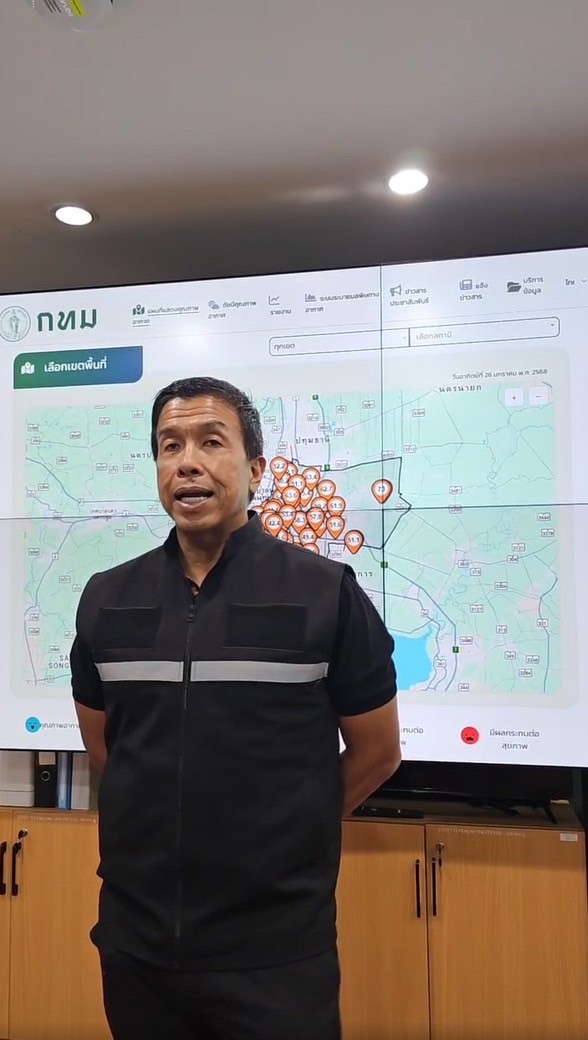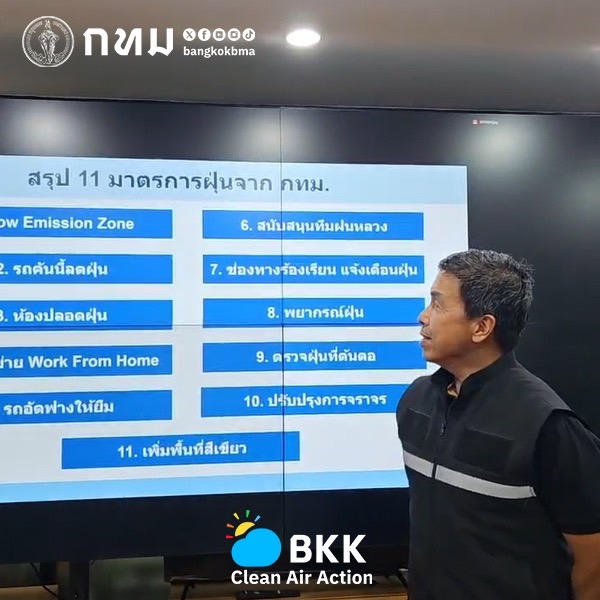January 26, 2025 – Bangkok Governor Mr. Chadchart Sittipunt, joined by Mr. Pornprom Vikitsreth, Adviser to Governor of Bangkok and Chief Sustainability Officer, delivered updates on the PM2.5 pollution situation in Bangkok. The press briefing, held at the Air Quality Information Center in Din Daeng District, highlighted ongoing measures to mitigate pollution and proposed expanded authority for the BMA to manage the issue more effectively.

Governor Chadchart stated that PM2.5 levels in Bangkok have shown improvement due to better air circulation. While the haze observed this morning may appear as dust, it is largely a result of high humidity forming water droplets that resemble fog. Air quality is expected to improve significantly between January 27 and 29, though a slight deterioration is forecast for January 30. Favorable conditions this week should help dissipate accumulated dust.
Current Pollution Trends
While Bangkok’s air quality is improving, several regions in Thailand, particularly in the central and northeastern provinces, are experiencing worsening pollution, marked by an increase in red zones on the air quality map due to biomass burning. Fires surrounding Bangkok remained prevalent on January 25, though favorable winds redirected some pollution away from the city.
Sources of PM2.5 and Mitigation Efforts
Governor Chadchart identified three primary sources of PM2.5 in Bangkok: vehicle emissions, closed atmospheric conditions, and biomass burning; this was confirmed by The Dust Detective Project, launched in 2022 in partnership with Kasetsart University (KU) and spearheaded by Assoc. Prof. Dr. Surat Bualert from KU’s Faculty of Environment utilizes advanced chemical analysis of dust particles to uncover the sources of PM2.5 pollution. The research indicates that during periods of low pollution with good air circulation, vehicle emissions are the primary contributor to fine particulate matter. However, during high-pollution episodes, the dominant source shifts to biomass burning. These findings are firmly supported by scientific data. The convergence of these factors can elevate pollution levels from moderate to unhealthy. To address this, the BMA has implemented 11 key measures:
- Low Emission Zones (LEZ): Restrictions on six-wheel trucks and larger vehicles without Green List registration are enforced in 9 districts and on roads traversing 13 districts. This policy marks Thailand’s first use of disaster prevention laws for pollution control, with over 38,000 vehicles now Green List registered.
- “This Car Reduces Dust” Program: Vehicle owners are encouraged to maintain their vehicles, with subsidies for oil and filter changes. This initiative has reduced emissions by up to 55% and has reached 260,752 participants, targeting 500,000.
- Dust-Free Classrooms: The BMA has upgraded 744 of 1,966 classrooms in its schools to create dust-free environments, with all upgrades scheduled for completion by year’s end.
- Work From Home (WFH): Nearly 100,000 individuals from 155 private companies are participating in the WFH initiative to reduce traffic emissions during high-pollution periods.
- Free Straw Compressors for Farmers: To minimize agricultural burning, the BMA provides free straw compressors in districts such as Nong Chok and Khlong Sam Wa.
- Royal Rainmaking Collaboration: The BMA works with the Department of Royal Rainmaking to conduct water spraying and dry ice operations to lower dust levels.
- Public Complaint Channels: Platforms like Traffy Fondue and LINE Alert enable residents to report black smoke emissions and receive real-time updates.
- Enhanced Air Quality Forecasting: The Air BKK app now provides accurate multi-day forecasts through advanced sensor technology.
- Source Inspections: Since October 2022, over 14,600 factory inspections and 2,400 cement plant inspections have been conducted, resulting in 17 closures for non-compliance.
- Traffic Improvements: The BMA is expanding pedestrian and bicycle lanes while implementing AI systems to optimize traffic flow.
- Green Space Expansion: Over 1.2 million trees have been planted, with a target of 2 million, alongside the continued development of 15-Minute Parks.
Proposals for Government Action
Governor Chadchart urged the national government to adopt several measures to strengthen Bangkok’s capacity to address PM2.5 pollution:
- Implementing an environmental taxation system under the “Polluter Pays Principle” as outlined in the Clean Air Act.
- Tightening vehicle emission standards by reducing the opacity threshold for black smoke emissions from 30% to 10%.
- Requiring immediate repairs for vehicles emitting black smoke, rather than allowing a 30-day compliance period.
- Extending inspection authority to allow BMA officers to inspect six-wheel trucks and larger vehicles.
Governor Chadchart highlighted that while many proposals remain under consideration, the lack of authority under existing laws limits Bangkok’s ability to enforce stricter pollution controls. For instance, a proposal to mandate a full transition of Bangkok buses to electric vehicles (EVs) within seven years was rejected due to these limitations.
“We continue to work tirelessly to address PM2.5 pollution. While some measures may require further refinement, others are starting to yield results. Feedback from residents is invaluable in helping us improve and make Bangkok a better city,” Governor Chadchart concluded.
#PM25 #BangkokAirQuality #CleanEnvironment #HealthyLiving




